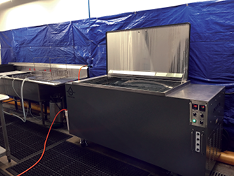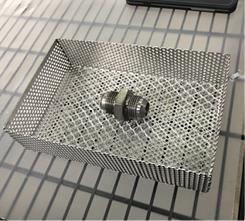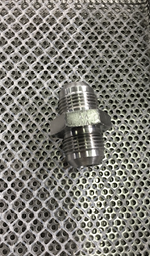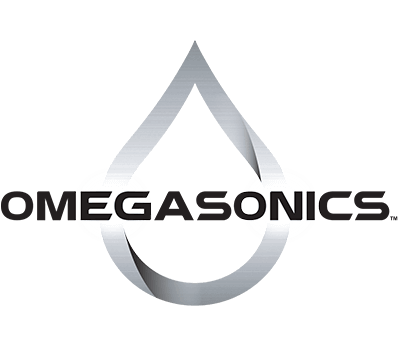“Aviation is the branch of engineering that is least forgiving of mistakes.” – Physicist Freeman Dyson. Even small traces of residue, grease, or grime on parts used to build and repair aircraft – from jets to rockets – can cause a catastrophic explosion. Therefore, these parts must be routinely and thoroughly cleaned to restore them to their original condition. However, precision cleaning and handling of these parts can become labor-intensive, lengthy, and quite costly.
With ultrasonic cleaning technologies, aircraft and rocket parts from small and lightweight to large and heavy are being cleaned in just minutes by using sound waves that gently remove particles and oily residues. This process restores the parts for flight and increases safety for the industry. In addition, handling time is reduced, allowing for significant savings for aerospace manufacturers and the firms providing ultrasonic cleaning services to them.
Outsourcing cleaning
For many aerospace manufacturers, maintaining a clean room and staffing it with trained technicians is expensive – especially if they don’t have a large quantity of parts that require regular cleaning. In addition, technicians often lack the experience to properly clean parts and equipment, so many turn to precision cleaning companies to do it for them. Even large aerospace manufacturers may outsource the cleaning process to be assured parts are being cleaned and handled by experts.
How ultrasonic cleaning works
Generators produce high frequency electricity that is then converted into sounds waves through a transducer, making the waves vibrate. As the waves travel through water, tiny vacuum bubbles form and repeatedly implode upon any surface they encounter, removing even microscopic dirt particles. These cavitation bubbles reach and clean grooves, cracks, and hidden crevices more effectively than alternative methods.
Ultrasonic cleaning technology does not require toxic chemicals or manual work, and many units use only water-based solutions.
Ultrasonic cleaning
Quality Precision Cleaning Inc. (QPC) of Duarte, California, a precision cleaning company, gets about 70% of its business from aerospace firms – mostly from space launch and rocket manufacturers.
Prior to the company’s adoption of ultrasonic cleaning equipment, it relied on manual power brushing. But this method wasn’t always effective, especially when cleaning small cavities and blind holes that are difficult to reach, such as manifolds with drilled holes inside – some as small as 1/8″. These components were very hard to clean with a brush because it was difficult to get the velocity to push out any contaminants.

QPC discovered that ultrasonic cleaning equipment could help with those internal cavities and hard-to-reach particles by loosening those contaminants so they could be flushed out easily. QPC chose to partner with Omegasonics of Simi Valley, California.
“The most important criteria for us were size, self-containment, and the setup of the machines. Omegasonics offered ultrasonic models that met our criteria and featured good recirculating flow and reflow, which was another important consideration for us,” says Jay Dino, general manager at QPC. “Their models had a very effective, closed-loop filtration system which keeps the tanks relatively clean. With our older tanks, we’d have to change fluid out every day. But, with our Omegasonics ultrasonic machines, we only have to change out liquid once a week,” Dino adds.
Also, Omegasonics was local, unlike other ultrasonic cleaning equipment manufacturers. From a customer service perspective, that was very comforting.
Additionally, some of QPC’s most prominent aerospace clients were already using Omegasonics equipment themselves.
“If Omegasonics ultrasonic cleaning systems were good enough for our customers, then they were good enough for us,” Dino says.
Omegasonics Power Pro 6000 & 8000 ultrasonic cleaning systems
The 85-gallon Power Pro 6000 is a large capacity ultrasonic cleaning system with 6,000W of peak ultrasound. This unit is 6″ deeper than Omegasonics’ smaller models and has a 24″ wide opening. The design lends itself to larger parts cleaning requirements, including transmission cases, larger castings and molds, and heat exchangers. The portable unit can be moved within a shop environment without a forklift. Features include:
- 85 gallons
- 4″ weir
- 1 phase/240VAC/30A
- 6,000W peak ultrasonic power
- Tank dimensions: 36″ x 24″ x 20″
- Overall dimensions: 69″ x 27″ x 37″
The Power Pro 8000 ultrasonic cleaner has a 110-gallon capacity and 8,000W peak ultrasonic cleaning for large-volume, large-power precision cleaning requirements. Applications include large aluminum and stainless steel housings, plastic injection molds, and heat exchangers. This unit’s features include:
- 110 gallons
- 4″ weir
- 1 phase/240VAC/50A
- 8,000W peak ultrasonic power
- Tank Dimensions: 48″ x 26″ x 20″
- Overall Dimensions: 86″ x 27″ x 37″
Both units use non-toxic, water-based solutions.
Reduced manipulation

For QPC, automating the entire cleaning process is not a good practice because it requires a tremendous amount of calibration and maintenance. And some parts demand a human touch to ensure they are completely and thoroughly cleaned. Omegasonics ultrasonic cleaning machines help them strike a good balance. They enable QPC to automate a good portion of its process but leave the door open to finish the cleaning with manual brushing and flushing.
“With the PowerPro 6000 and PowerPro 8000, we’ve been able to reduce the time spent manually manipulating parts by 40%,” Dino says. “That directly translates to a significant cost savings.”
Omegasonics also offers ongoing customer service and support – something that QPC has especially valued.

“They are truly experts in the ultrasonic cleaning field. We’ve been very impressed with their knowledge base. They told us precisely how to balance our equipment to provide sufficient power to get an adequate clean,” Dino adds.
Omegasonics
Quality Precision Cleaning
About the author: Joe Gilbert is Omegasonics’ sales manager. He can be reached at or 805.583.0875.
